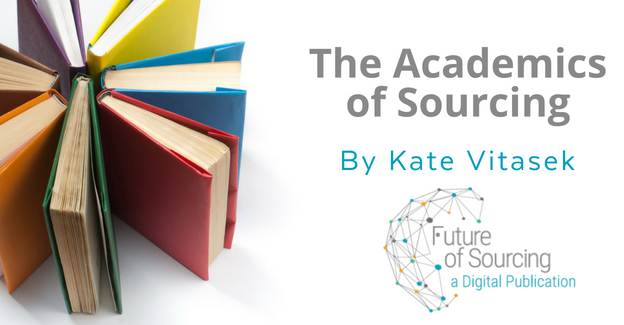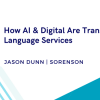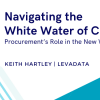This article originally appeared in Outsource Magazine Issue #27 Spring 2012
Deciding to outsource demands a thorough make/buy analysis. However, far too many companies take the concept of make-or-buy as black and white. Dr. Oliver E. Williamson challenged the traditional make/buy decision process with his Nobel Prize-winning work in the area of transaction cost economics. Williamson received the Nobel Prize in 2009.
One of Williamson’s key lessons is that companies should view outsourcing as a continuum rather
than a simple market-based make-versus-buy decision. Perhaps the best way to think of Williamson’s work is to consider free market forces on one side and what Williamson refers to as “corporate hierarchies” – an insourced decision – on the other.
Figure 1

Using the market may not be the right approach
Companies that choose to outsource typically use what Williamson describes as “the market” for buying goods and services. The market uses the conventional free market economy for determining how companies will do business, including establishing a price. The market assumes that free market forces incentivise suppliers to compete on low cost and high service. The market approach assumes an absence of dependency; if buyers or suppliers are not happy, they can switch at any time with relative ease. Governance of the supply base is typically accomplished by switching suppliers or customers if a better opportunity comes along.
The big advantage to using the market in the decision to outsource is that it enables a competitive process in determining whether a company is getting a good transaction price. The downside to the market is that it often assumes that the service acquired is somewhat standardised and therefore available from a variety of suppliers. Consequently service providers are often “competed” into outsourcing agreements that pose unnecessary risks. For example, Williamson points out that service providers might have “specialised investments” that can easily expose the business to significant loss if the contract fails and for which no safeguards have been provided. Often this investment is made to support innovation, which in turn provides a higher value offering or a more efficient business model. To protect themselves, service providers will raise their price to reflect the level of risk they have taken. To counteract this, and thus provide a more acceptable price to the customer, service providers will often negotiate heavily for contract safeguards in the absence of certainty. This “give and take” is a normal part of market-based negotiations.
The catch-22
Deciding to keep work insourced versus outsourced is rarely a yes or no decision. Although each approach offers advantages, a real catch-22 has emerged for companies that want to drive innovation and create a competitive advantage, yet still want to outsource a particular activity.
The catch-22 comes into play because companies that are using conventional arrangements are finding that their service providers are meeting contractual obligations and service levels – but they are not driving innovations and efficiencies at the pace they would like to see. Suppliers argue that investing in their customers’ business is risky because buyers will simply take their ideas and competitively bid the work. Companies want solutions to close the gaps, but they do not want to make investments in people, processes and technology where they do not have a core competency. The result is that the industry is at a crossroads, with both buyers and service providers wanting innovation – but neither wanting to make the investment due to the conventional transaction-based commercial structure of how the companies work together.
The rise of a hybrid approach
Because of this catch-22, Williamson advocated for a third “hybrid approach” as the preferred method for dealing with complex services where there is a high level of dependency, the market cannot be used to switch suppliers freely and where an insource solution may not be a good fit.
Companies that use a hybrid approach can apply various approaches with suppliers to create strategic and longer-term relationships that can balance the weaknesses found in a pure market-based or pure insource-based approach.
The University of Tennessee (UT), the Sourcing Interests Group (SIG), Centre for Outsource Research and Education (CORE) and the International Association for Contract and Commercial Management (IACCM) teamed to examine various sourcing business models. The result was a pioneering white paper outlining seven sourcing business models, including the hybrid approach most often referred to as Vested Outsourcing. These seven sourcing business models should be considered as tools in the procurement and outsourcing professional’s toolkit. Each of the sourcing business models is summarised in this article and the complete white paper has been made available for free download at the University of Tennessee’s dedicated website devoted to outsourcing at www.vestedoutsourcing.com.
Seven sourcing models
Sourcing business models fall into three categories: transaction-based, outcome-based and investment-based. Today, most companies operate under conventional transaction-based models. However, outcome-based approaches are gathering momentum as companies see positive results from carefully crafted collaborative agreements.
Transaction-based models
Most companies use transaction-based business models when outsourcing. Transactional contracts are structured where the supplier gets paid by the transaction – typically with a pre-defined rate for each transaction, or unit of service. For example, a third-party logistics service provider would get paid monthly for the number of pallets stored, the number of units picked, and the number of orders shipped. A call centre service provider would get paid a price per call or a price per minute.
There are three types of transaction-based business models; simple PO-based, approved provider and preferred provider. A transaction-based approach works best when a supplier is supplying a standardised service.
Outcome-based business models
An outcome-based business model pays a service provider for the realisation of a defined set of business outcomes, business results, or achievement of agreed on key performance indicators. Outcome-based business models have gained in popularity in the last few years. A well-structured outcome-based agreement compensates a service provider’s higher risk with a higher reward. However, many companies wrongfully structure deals around “all risk, no reward”; in such cases, a supplier or service provider that does not meet the desired results is penalised.
There are two types of outcome-based business models: a performance-based agreement and a Vested Outsourcing agreement.
Figure 2

Investment-based model (insource)
Companies that struggle to meet complex business requirements using conventional transaction-based or outcome-based approaches typically invest to develop capabilities themselves (or insource). In such cases, many companies have chosen to adopt what is commonly referred to as a “shared services” structure which is the establishment of an internal organisation modelled on an arms-length outsourcing arrangement. Using this approach, processes are typically centralised into a shared service organisation and departments are cross-charged for the services used.
Some companies decide they do not have the internal capabilities, yet they do not want to outsource for a variety of reasons. In these cases, companies may opt to develop a joint venture or other legal form in an effort to acquire mission-critical goods and services. These equity partnerships can take different legal forms, from buying a service provider, to becoming a subsidiary, to equity-sharing joint ventures. These partnerships often require the strategic interweaving of infrastructure and heavy co-investment. Equity partnerships, by default, bring costs “in house” and create a fixed-cost burden. As a result, equity partnerships often conflict with the desires of many organisations to create more variable and flexible cost structures on their balance sheets.
Business mapping model: a decision framework
Figure 2 graphically maps the seven sourcing business models. The axes used to classify the business models are that of dependency and shared value. The more dependency, the more the market should not be used. The second axis is that of shared value. The more potential reward to an organisation, the more a company should strive to use risk/reward incentives that are inherent in outcome-based or investment-based approaches.
Summary
As companies strive to transform their operations through outsourcing or seek innovation from their suppliers, they will most certainly need to better understand their business environment and the various sourcing business models that are available. It is important that today’s business leaders understand the fundamental differences of each type of sourcing business model and consciously strive to pick the right model for the right environment, ultimately picking the right approach to use for the right job.
As you embark on your journey to outsource more effectively, SIG, CORE, IACCM and UT urge you to consider the fact that outsourcing is more than a make/buy decision – it is a continuum. As a sourcing, contracting or outsourcing professional it is your job to understand your business environment and use the right sourcing business model that will best accomplish your objectives.
About the Authors
Kate Vitasek is a faculty member at the University of Tennessee’s Centre for Executive Education, and an internationally recognised innovator in the practice of supply chain management and outsourcing.
Bonnie Keith is an adjunct faculty in the University of Tennessee’s Centre for Executive Education and is the President of The Forefront Group, LLC, an international leader in strategic sourcing transformation concepts.






